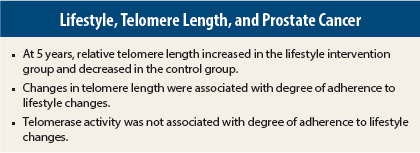Short telomere length in peripheral blood mononuclear cells is associated with aging and age-related diseases such as cancer, stroke, vascular dementia, cardiovascular disease, obesity, osteoporosis, and diabetes. Telomere attrition is considered a potential mechanism in triggering the chromosomal rearrangement observed in prostate cancer, with variable telomere length in prostate cancer cells and short telomere length in prostate cancer-associated stromal cells being associated with increased risk of metastasis or death from prostate cancer.
Dean Ornish, MD, of the University of California San Francisco and Preventive Medicine Research Institute in Sausalito, and colleagues previously reported an association between 3 months of comprehensive lifestyle changes and increased telomerase activity in peripheral blood mononuclear cells in a small pilot study in men with low-risk prostate cancer.1 In a long-term follow-up reported in The Lancet Oncology, Ornish and colleagues found increases in relative telomere length after 5 years in patients in the lifestyle intervention group.2 This is the first controlled study showing that an intervention may increase telomere length.
Study Details
The follow-up study compared 10 lifestyle intervention group patients and 25 controls with biopsy-proven low-risk prostate cancer who had chosen to undergo active surveillance. Men in the intervention group followed a program of comprehensive lifestyle changes and men in the control group underwent active surveillance alone.
Blood samples were taken at 5 years to determine relative telomere length and telomerase activity and values were analyzed according to degree of lifestyle changes. Lifestyle index scores were calculated to reflect mean percentage of adherence to the initial lifestyle intervention, with a score of 1.0 indicating 100% adherence.
Lifestyle Intervention
The lifestyle intervention consisted of the following: a diet high in whole foods, plant-based protein, fruits, vegetables, unrefined grains, and legumes, and low in fat (approximately 10% of calories) and refined carbohydrates, with take-home meals being provided to patients for the first 3 months of the intervention; moderate aerobic exercise (eg, walking 30 minutes per day on 6 days per week); stress management (eg, gentle yoga-based stretching, breathing, meditation, imagery, and progressive relaxation for 60 minutes daily); and increased social support (eg, 60-minute support group sessions once per week).
At each weekly support session, patients performed 1 hour of moderate exercise supervised by an exercise physiologist and 1 hour of stress-management techniques supervised by a certified stress-management specialist and attended a 1-hour support group led by a clinical psychologist and a 1-hour lecture during dinner, generally from a dietitian, registered nurse, or physician. All members of the intervention staff were available to answer patient questions and to provide counseling at the weekly support sessions. Spouses and partners were encouraged to attend support sessions but were not required to do so.
After the first 3 months, meetings were not mandatory, but intervention group patients could continue to meet on their own for two 4-hour meetings per month for the duration of the study. A physician or nurse was on site during meetings, and patients could request that other clinical staff attend or be available by telephone at these times.
Change in Telomere Length
There were no significant differences at baseline between the intervention group and the control group in age, weight, body mass index, or blood pressure. Median lifestyle adherence scores at baseline were 0.58 (interquartile range [IQR] = 0.31–0.79) in the intervention group and 0.60 (IQR = 0.32–0.72) in the control group.
At 5 years, relative telomere length increased from baseline by a median of 0.06 telomere to single-copy gene ratio (T/S) units (IQR = 0.05–0.11) in the lifestyle intervention group and decreased by a median of 0.03 T/S units (IQR = –0.05 to 0.03; P = .03). Relative telomere length decreased in 16 (64%) of 25 control patients and in 3 (30%) of 10 intervention patients. That said, there was a 10% average increase in telomere length in the lifestyle intervention group but a 3% average shortening in telomere length in the control group.
Three patients in the intervention group received conventional treatment during the study, with two undergoing brachytherapy (at 17 and 24 months after enrollment) and one having hormonal treatment (at 25 months). Two control group patients received conventional treatment during the study, with one having radical prostatectomy (at 15 months) and one undergoing brachytherapy (at 39 months). In analysis excluding these five patients, the increase in relative telomere length in the intervention group was slightly smaller (0.05 T/S units) but remained significant compared with the control group (P = .05).
Association of Adherence and Telomere Length
Median changes in lifestyle adherence scores changes were 0.22 (IQR = 0.13–0.36) in the intervention group vs –0.06 (IQR = –0.17 to 0.08) in the control group. The median lifestyle score change for the three intervention group patients in whom relative telomere length decreased was 0.13 units (IQR = 0.03–0.34), compared with 0.29 units (IQR = 0.21–0.56) for those whose relative telomere length increased.
When data from the two groups were combined, adherence to lifestyle changes was significantly associated with relative telomere length on multivariate analysis adjusting for age and length of follow-up; for each percentage point increase in lifestyle adherence score, T/S units increased by 0.07 (P = .005). Age at the end of the study was also significantly associated with relative telomere length; for each year increase in age, T/S units decreased by 0.005 (P = .007).
Telomerase Activity
At 5 years, telomerase activity had decreased from baseline by a median of 0.25 (IQR = 2.25 to 2.23) units in the intervention group and by a median of 1.08 (IQR –3.25 to 1.86) units in the control group (P = .64). Telomerase activity was not associated with adherence to lifestyle changes (relative risk = 0.93, P = .57).
The investigators concluded, “Our comprehensive lifestyle intervention was associated with increases in relative telomere length after 5 years of follow-up, compared with controls, in this small pilot study. Larger randomised controlled trials are warranted to confirm this finding.”
Disclosure: The study was funded by the U.S. Department of Defense, National Institutes of Health/National Cancer Institute, and others. For full disclosures of the study authors, visit
www.thelancet.com.
References
1. Ornish D, Lin J, Daubenmier J, et al: Increased telomerase activity and comprehensive lifestyle changes: A pilot study. Lancet Oncol 9:1048-1057, 2008.
2. Ornish D, Lin J, Chan JM, et al: Effect of comprehensive lifestyle changes on telomerase activity and telomere length in men with biopsy-proven low-risk prostate cancer: 5-year follow-up of a descriptive pilot study. Lancet Oncol 14:1112-1120, 2013.



